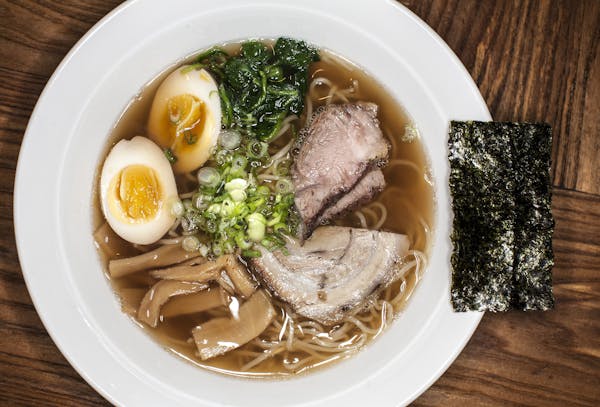It was the last meal in Tokyo, after many delicious days in Japan. Emphasis here on delicious, with one meal trumping the next, day after day. A final taste of the island was all we craved, in the form of a simple bowl of ramen, the classic Japanese dish.
This was not the familiar stuff of cellophane packages that sells in supermarkets at $1 per dozen. Rather, it was the rich, steaming broth, topped with fresh wheat noodles, sliced meat and chopped vegetables that made diners slurp and sigh before slurping and sighing again. It was a meal in a bowl, satisfying and filling at any hour — and every hour — but especially at 9 a.m. on a damp winter morning in Tokyo when the chill had us in its grips.
Though small noodle shops dotted the streets near our hotel, we headed to Tsukiji, the biggest wholesale fish and seafood market in the world, where bustling food stalls thrive along the perimeter of a massive, covered war zone of fish processing.
We had spotted a vendor on an earlier visit when we had passed quickly — longingly — to watch seafood prepped for sale. "We'll be back," we promised ourselves, and so we were in the waning hours of our trip.
It was there my epiphany took place at the end of a pair of chopsticks.
In a narrow stall, tucked between a tuna purveyor on one side and a salmon merchant on the other, ceramic bowls were lined up like dominoes.
The older of two workers — dressed in chef's whites and likely the proprietor, though our language skills kept us from finding out — ladled a small puddle of dark, fragrant broth into each bowl while customers queued up at the side. We scrambled into formation as he dropped tender greens into the bowls, then reached for the seasoning to strew over each.
When the second worker glanced our way, we raised our hands, each with a finger to signal that we wanted one bowl. He nodded, then plucked a slab of cooked pork from the table, carefully slicing it in thin, yet substantial pieces.
In moves precise as any ballet, the proprietor ducked behind him and scooped noodles out of the pot on the stove before dropping them into each bowl, then dribbling yet more broth over it all.
Seamlessly, the second worker took over, arranging pork slices over the noodles. With a hint of dramatic flair, the proprietor sprinkled a final flourish of sliced green onions. Breakfast was ready.
There is no delicate way to eat ramen, which is unruly at best with a tangle of noodles that seems to defy a beginning or end. Or at least they did for us, three Americans who were hungry for yet another culinary adventure.
So we did what the locals do, chopsticks poised, noodles askew, though perhaps not with the grace of those around us. We slurped because, well, everyone around us was slurping.
I wiped away the driblets of broth that had landed on my chin and breathed in its hearty perfume before nabbing a slice of tender pork.
Then I knew. "This is the perfect meal," I thought, "in the perfect place, with the perfect companions."
The universe had shifted course for me as I leaned against the high-top metal counter, bowl of ramen front-and-center, the clamor of street activity all about me.
Sole meunière may have changed Julia Child's life. A bowl of ramen changed mine.
The pork broth in this particular ramen takes at least six hours of boiling. For the curious and committed cook, check out our blog for the recipe at www.startribune.com/ tabletalk, or try the modified homestyle variation here. And enjoy a bowl of ramen from one of our Twin Cities restaurants.
Follow Lee Svitak Dean on Twitter: @StribTaste
Singing, ceremonies and straw hats: Olympics opening ceremony in Tahiti centers Polynesian culture

Three 101-year-old friends recall fond memories in 1940s Alexandria
Celine Dion makes musical comeback at Paris Olympics with Eiffel Tower serenade

